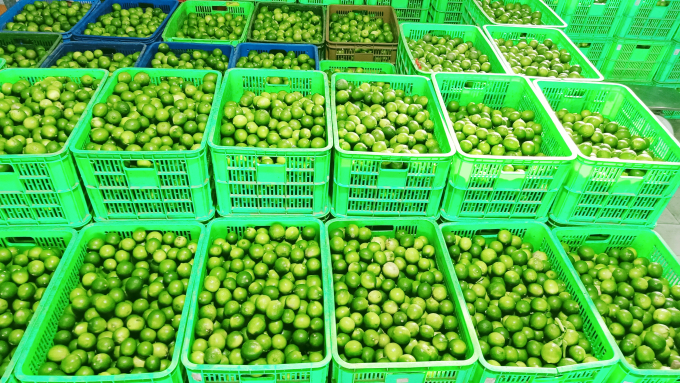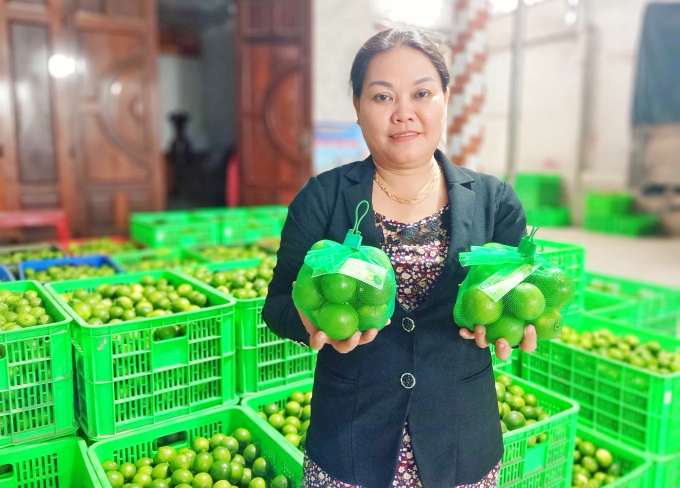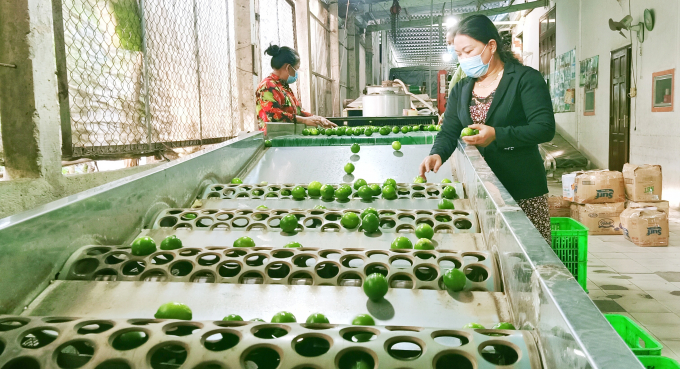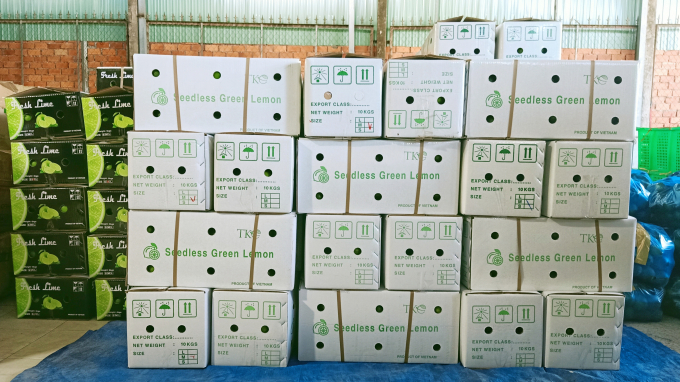November 27, 2025 | 12:18 GMT +7
November 27, 2025 | 12:18 GMT +7
Hotline: 0913.378.918
November 27, 2025 | 12:18 GMT +7
Hotline: 0913.378.918

Seedless lemon of Thanh Phuoc Cooperative (Chau Thanh district, Hau Giang province). Photo: Kim Anh.
In recent years, seedless lemon has been known as one of the strong export agricultural products of Hau Giang province and is grown widely in Dong Thanh commune, Chau Thanh district.
Facing the fluctuations of the Chinese agricultural market, a seedless lemon cooperative in Chau Thanh district, Hau Giang province has shifted its development direction, focusing on stable and sustainable consumption markets.
At Thanh Phuoc Seedless Lemon Cooperative in Dong Thuan hamlet, Dong Thanh commune, 10 - 15 tons of seedless lemons are consumed on average every day. Of which, domestic consumption at large wholesale markets in Ho Chi Minh City such as Thu Duc, Binh Dien, and Hoc Mon is about 3 tons; the rest of these products are exported to markets such as Middle East countries, China, Cambodia, with an offtake contract price of VND 25,000 per kg with exporters.
China has been a traditional market, with big purchased volume yearly. But the cooperative has to leave this market due to the unstable requirements, and now it is pursuing other more stable and sustainable markets.

Ms. Nguyen Thi Thiet, director of Thanh Phuoc Seedless Lemon Cooperative, says that seedless lemons have a stable export market. Photo: Kim Anh.
Ms. Nguyen Thi Thiet, director of the cooperative, says that before the Covid-19 pandemic outbreak, each day, the cooperative exported about 3 - 4 tons of seedless lemons to the Chinese market. But from the outbreak of Covid-19, it was difficult to transport, sometimes it was not possible to export, forcing the cooperative to cut the number of orders to 50-60%, minimizing the number of new orders. And from the early 2022, the cooperative stopped exporting to China completely.
“Exporting to China requires many difficult procedures, such as packing in styrofoam, freezing, wrapping, etc., but compared to markets in the Middle East and Cambodia, the profit value is similar. Therefore, we do not export seedless lemons to China anymore, focusing on other markets instead," Thiet says.
Currently, each week, Thanh Phuoc Cooperative fills 3 containers, equivalent to 60 tons of seedless lemons to serve export to Middle Eastern countries. Besides, every day the cooperative also exports 5 - 6 tons of seedless lemons to Cambodia directly by road.

The process of drying and polishing the seedless lemon before being packaged. Photo: Kim Anh.
According to Ms. Thiet, in the situation that agricultural products are facing difficulties in exporting to China, the cooperative's seedless lemon products are still being consumed stably. Talking about the reason to bring such good results, Ms. Thiet said that the cooperative has chosen “not to be dependent on the Chinese market alone”.
“China closes the border gate from time to time, so it is very difficult for goods to be exported. The cooperative has been developing for 20 years and has never been dependent on the Chinese market. Seedless lemon is a popular agricultural product, so when developing, the cooperative also chooses not to be dependent on any specific market. Seeing that the price of agricultural products, especially jackfruit, has dropped, it is very hard for farmers growing jackfruit in the area to cut down and replant other trees”, Ms. Thiet says.

Packages of seedless lemons for export to the Middle East market. Photo: Kim Anh.
During the outbreak of the Covid-19 pandemic in 2021, while many agricultural products were sold with difficulty, the seedless lemons of Thanh Phuoc Cooperative were still regularly exported to China or Cambodia markets, however the volume was somewhat limited, cut down according to market demand. According to Ms. Thiet, an important point to create stability and sustainability for the cooperative's seedless lemon product is the close coordination with the Hau Giang Cooperative Alliance to support product consumption, thereby create confidence for farmers.
Ms. Thiet added: “Farmers trust their cooperative, so we have to create trust for them to produce, from then, our cooperative will be further developed. When can't be exported, seedless lemon still has stable domestic consumption with about 10 tons purchased daily. In recent years, many farmers in the region have escaped poverty thanks to the seedless lemon tree."
The Thanh Phuoc Cooperative currently has nearly 100 hectares of seedless lemon growing area. Besides Thiet herself has invested in a 40-hectare seedless lemon farm in Dong Nai province, providing an output of about 10 tons of seedless lemons to create a sustainable raw material area for the cooperative. In addition, each year the cooperative also provides more than 200,000 seedlings to farmers in Soc Trang province.
Ms. Nguyen Thi Thiet, Director of Thanh Phuoc Seedless Lemon Cooperative says that the technical process of growing seedless lemons is not difficult. Lemon trees planted for a year and a half will have fruit, do not need much care and high fertilizer costs. At harvest time, a lemon tree will give 5 - 10 kg of fruit. Fruit is harvested once a month, and 99% of fruits meets the required standard.
Translated by Duc Thuan

(VAN) China’s cooking oil is suddenly flooding into India. It all comes down to a soybean surplus that Beijing doesn’t quite know what to do with.

(VAN) An Giang promotes supply-demand connections, standardizes quality and builds value chains, creating a foundation for sustainable bird’s nest development and aiming to expand exports.
/2025/11/24/5339-4-nongnghiep-075331.jpg)
(VAN) Recently, the conference on 'Sustainable Fisheries Linkage Chain - Tilapia for Export' took place in Tien Hai commune, Hung Yen province.
/2025/11/21/4309-2-153400_128.jpg)
(VAN) Green and low-emission rice is paving the way for Vietnamese rice to enter high-end markets, marking the beginning of a transformation journey toward greening and elevating the national rice brand.

(VAN) ‘Right to Win’ outlines a national action plan that shapes a new vision for Viet Nam’s agriculture in an era of renewal and global integration.

(VAN) Lam Dong’s farmed sturgeon output this year is expected to reach 2,300 tons, worth VND 450 billion, affirming the brand’s position on the market.

(VAN) A surge in Ukrainian egg exports, largely driven by soaring sales to the UK over the last few years, has notably pushed up egg prices on the domestic market.